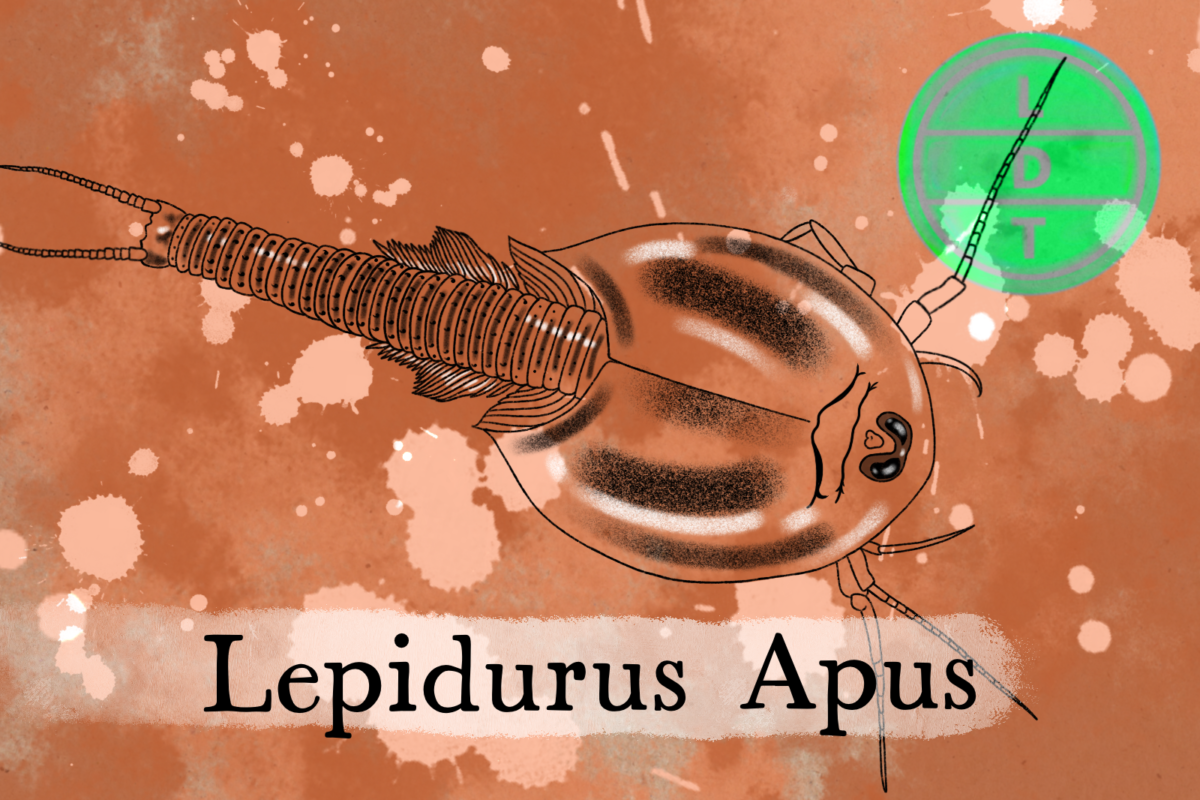“…and today we’re talking about a crustacean that’s coming for your rice crispy treats. But more on that later.”
What if you lived in a place that was sometimes uninhabitable for years? You’d have to prepare for the lean years. In fact, you’d need a bunker. Such is the way of the tadpole shrimp. They live in fields and meadows, but they are a fully aquatic crustacean. You don’t need to be a biologist to see the problem they have. But with these property tax rates, the trials and tribulations of finding a place to live seems to be a fact of Life, Death, and Taxonomy.
Description of the Tadpole Shrimp
- It doesn’t look like your typical shrimp. It really looks like a tiny horseshoe crab or a trilobite.
- Has a wide, yellow/brown, disc-shaped shell covering the top two-thirds of its abdomen. The last third of its abdomen looks like a shrimp tail and ends with two tails that split off.
- Its shell is topped with two compound eyes like a housefly’s.
- Underneath, it has up to 88 little facehugger feet used for putzing around your local pond.
Measure Up
Welcome to the beloved Measure Up segment. The official listener’s favorite part of the show! The part of the show when we present the animal’s size and dimension in relatable terms through a quiz that’s fun for the whole family. It’s also the part of the show that’s introduced by you when you send in audio of yourself saying, singing, or chittering the words Measure Up into ldtaxonomy at gmail dot com. We don’t have a new Measure Up intro.
Adult Length
- 2–5 centimeters (0.8–2.0 in)
- How many Tadpole shrimp go into the length of the ark?
- Hint: In Genesis, the ark is described in cubits, which is believed to be the length from your elbow to your fingertips, which is generally around 18 inches. It was 50 cubits wide, which is around 86 feet.
- 3,060 notostraca. The ark was recorded to be 300 cubits or 510 feet.
First Instar Larva Length
- 0.2 inch (5 mm)
- How many larvae go into the height of Half Dome?
- Hint: Half Dome is the famous peak rising above Yosemite Valley and a popular hiking destination. Around 50,000 people climb the mountain each year. Its steep cable section, combined with the high number of people it sees per year, contributes to Yosemite’s 15 or so person annual death toll.
- 538,825 notostraca. Half Dome is 8,839 feet above sea level.
Fast Facts about the Tadpole Shrimp
- Range: Lives in temporary freshwater ponds around the world. Specifically in New Zealand, Australia, Iran, Israel, France, Germany, Italy, Denmark, and Austria.
- It likes seasonal ponds, ones that fill up during the rainy season and dry out later.
- Diet: plant matter, mostly floating detritus, and small aquatic invertebrates as well as algae, myxozoa, bacteria and fungi.
Major Fact: Rice Lice
Tadpole shrimp are a rice farmer’s bane. In the wild, they eat aquatic plants, small invertebrates, and sediment. But in civilization, they just love rice paddies.
Rice is grown in flooded fields, which protects young seedlings and rice roots from the harsh heat. Seedlings sprout underwater and then grow in the open air. But it’s during this critical period that the tadpole shrimp are most dangerous to a young rouse.
Tadpole shrimp damage rice in three ways. First, they like to chew off the coleoptile, which is a sheath that protects grass shoots. Then they eat the grass and roots.
Second, they dig to bury their eggs in the mud, which uproots rice seedlings.
Finally, digging makes the water brackish which blocks out vital sunlight and stunts plant growth.
What is a young rice shoot to do? Grow.
Like a reverse sea turtle, they can reach safety as soon as they get out of the water. When the plant emerges from the shallow water, it gets all the sunlight it needs, and I assume that the plant is too big to be uprooted by egg-laying activities.
Farmers need to plant rice quickly after a field is flooded, to give plants a chance to grow out of the water before tadpole shrimp colonies gain a foothold.
However, tadpole shrimp are like anime antagonists that turn to allies later in the series. Rice plants that grow past their vulnerability to these creeping crusties end up benefiting from their presence. The shrimp turn their culinary attention to any weeds in the rice field that might steal nutrients from the rice plant.
But tadpole shrimp are aquatic creatures, and, in the off-season, rice fields are dusty dry ground.
So where do the tadpole shrimp come from?
Tadpole shrimp lay eggs in the mud and then die after about a month. But the eggs have a tough shell which endures the dry season in the soil. When the field floods, they hatch, starting the cycle over.
What if farmers don’t irrigate the rice field next year? What if rains don’t allow for rice in that field? No problem. Eggs without the right moisture or temperature enter a state of diapause, which is halted growth that doesn’t lead to hatching. The eggs can survive being completely dehydrated for years. They lie in the earth, waiting for the wet activation of a spring rain like the Winter Soldier.
If your rice field has a significant tadpole shrimp problem, the typical response is to use pyrethroid insecticides. However, an alternate shrimp tadpole management practice involves using mosquitofish, which have a taste for tiny crustaceans.
Ending: So pick a pond, any pond, sow your wild cysts, and wait until your ditch fills with water like the tadpole shrimp here in LDT.

